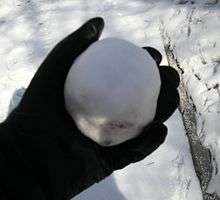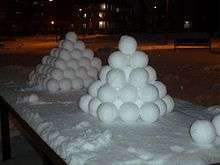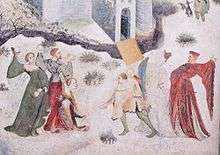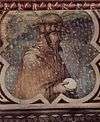Snowball
A snowball is a spherical object made from snow, usually created by scooping snow with the hands, and pressing the snow together to compact it into a ball.[1] Snowballs are often used in games such as snowball fights.

A snowball may also be a large ball of snow formed by rolling a smaller snowball on a snow-covered surface. The smaller snowball grows by picking up additional snow as it rolls. The terms "snowball effect" and "snowballing" are derived from this process. The Welsh dance "Y Gasseg Eira" also takes its name from an analogy with rolling a large snowball. This method of forming a large snowball is often used to create the sections needed to build a snowman.
The underlying physical process that makes snowballs possible is sintering, in which a solid mass is compacted while near the melting point.[2] Scientific theories about snowball formation began with a lecture by Michael Faraday in 1842, examining the attractive forces between ice particles. An influential early explanation by James Thomson invoked regelation, in which a solid is melted by pressure and then re-frozen.[3]
When and how
When forming a snowball by packing, the pressure exerted by the hands on the snow is a determinant for the final result. Reduced pressure leads to a light and soft snowball. Compacting humid or "packing" snow by applying a high pressure produces a harder snowball, sometimes called an ice ball, which can injure an opponent during a snowball fight.
Temperature is important for snowball formation. It is hard to make a good snowball if the snow is too cold.[1] In addition, snowballs are difficult to form with a dry powdery snow. In temperatures below 0 °C (32 °F), there is little free water in the snow, which leads to crumbly snowballs. At 0 °C (32 °F) or above, melted water in the snow results in a better cohesion.[4] Above a certain temperature, however, the snowball too easily becomes slush, which lacks mechanical strength and no longer sticks together.[5] This effect is used in the rule that, in skiing areas, there is a high risk of avalanche if it is possible to squeeze water out of a snowball.[6]
Natural snowballs
Under certain unusual circumstances, natural snowballs form as a result of wind, without human intervention. These circumstances are:[7]
- The ground must have a top layer of ice. This will prevent the snowball from sticking to the ground.
- That ice must have some wet and loose snow that is near its melting point.
- The wind must be strong enough to push the snowballs, but not too strong.
In Antarctica, small windblown frost balls form through a different process that relies on electrostatic attraction;[8] these wind-rolled frost balls are known as yukimarimo.
Under other rare circumstances, in coastal and river areas, wave action on ice and snow may create beach snowballs or ball ice.[9]
._05.jpg) Ball ice
Ball ice Yukimarimo
Yukimarimo_(Newark%2C_Ohio%2C_USA)_53_(46107487244).jpg) Wind-rolled snowball
Wind-rolled snowball Beach snowball showing signs of denivation
Beach snowball showing signs of denivation
Literary allusion
A snowball that turns into a child is a protagonist in a 1969 children's fantasy novel, The Snowball, by Barbara Sleigh.[10]
Gallery
 A collection of snowballs. |
 A medieval image from Italy of people throwing snowballs |
 Ambrogio Lorenzetti's Winter |
References
- Schmitz, Kenneth S (2016). Physical Chemistry: Concepts and Theory. Elsevier. p. 206.
- Denny, Mark (2011). Gliding for Gold: The Physics of Winter Sports. JHU Press. ISBN 9781421402154.
- Riley, Frank (1988-01-14). "A snowball's chance". New Scientist.
- Steinkogler, Walter; Gaume, Johan; Löwe, Henning; Sovilla, Betty; Lehning, Michael (2014). Granulation of Snow: Experiments and Discrete Element Modeling (PDF). International Snow Science Workshop. Baniff. pp. 733–737. Archived from the original (PDF) on 28 March 2020. Retrieved 28 March 2020.
- Morag Challenor (2006). "No-Ball Snow". In New Scientist (ed.). Does Anything Eat Wasps?: And 101 Other Unsettling, Witty Answers to Questions You Never Thought You Wanted to Ask. Simon and Schuster. p. 157. ISBN 9780743299176.
- Luo, Jian (2012-01-16). "Developing Interfacial Phase Diagrams for Applications in Activated Sintering and Beyond: Current Status and Future Directions". Journal of the American Ceramic Society. doi:10.1111/j.1551-2916.2011.05059.x.
- Rare self-rolling giant snow balls found in UK Archived 2010-01-12 at the Wayback Machine, The Telegraph, January 8, 2010
- J. Nelson & M. Baker (2003). "Charging of ice-vapor interfaces" (PDF). Atmospheric Chemistry and Physics Discussions. 3: 41–73.
- Emerson, Sarah (8 November 2016). "Thousands of Snowballs on This Siberian Beach Are Straight From a Fairy Tale". Motherboard. Vice Media. Archived from the original on 9 November 2016. Retrieved 8 November 2016.
- University of Oxford libraries Retrieved 14 September 2018.
| Look up snowball's chance in hell in Wiktionary, the free dictionary. |
| Wikimedia Commons has media related to Snowballs. |